Measuring QR Code ROI: Campaigns, Data, and Real Impact
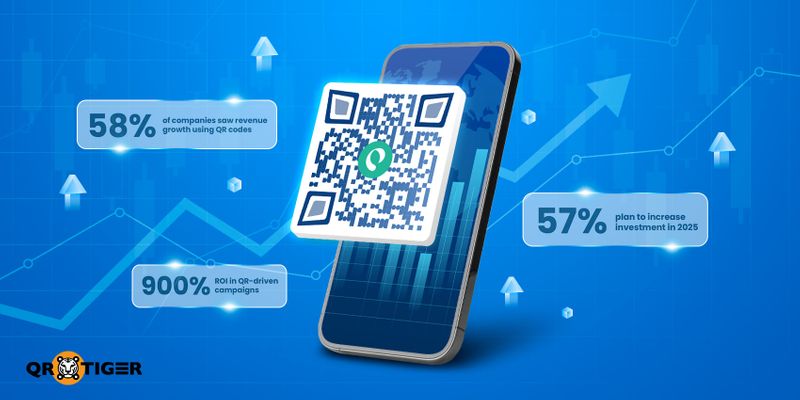
Scanning a QR code is simple, but is the value for brands just as clear? A closer look at QR code ROI explains why more brands are building it into their core strategies.
Return on investment (ROI) is about what you get back for what you put in, and with QR code technology, the value is clear: low cost, high engagement, and trackable conversions.
About 58% of companies experienced revenue growth by integrating QR codes into their customer interactions. In 2025, more than half of businesses aim to allocate more resources toward them, highlighting the significant ROI they offer.
In this article, we break down the different ways to calculate and grow your ROI with QR codes with latest stats, case studies, and expert tips to support.
Table of Contents
- What is QR code ROI?
- Why monitoring matters
- The ROI potential of QR code campaigns
- Best practices for growing ROI of QR code campaigns
- ROI calculation framework for QR code campaigns
- QR code campaign benchmarks: Sector-wise analysis
- Case studies: QR code marketing success across industries
- Preparing for the next phase of QR adoption
- Increase your ROI with QR codes
What is QR code ROI?
The ROI of QR code is a measure of the profitability of a business’ investment relative to the cost of using QR codes in their campaigns, customer interactions, and overall marketing strategies.
It works much like traditional marketing ROI, comparing the gains against the costs, but with unique advantages tied to the digital nature of QR codes.
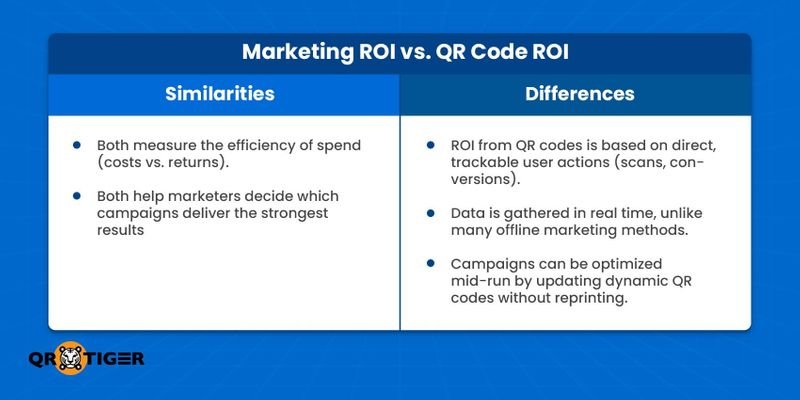
- It proves the value of QR code campaigns to stakeholders.
- It helps identify high-performing touchpoints and eliminate wasted spend.
- It guides smarter resource allocation toward strategies that deliver measurable engagement.
- It builds long-term efficiency by continuously testing and refining campaigns.
QR codes created with a dynamic QR code generator are fully trackable, giving marketers real-time data to connect spend with performance.
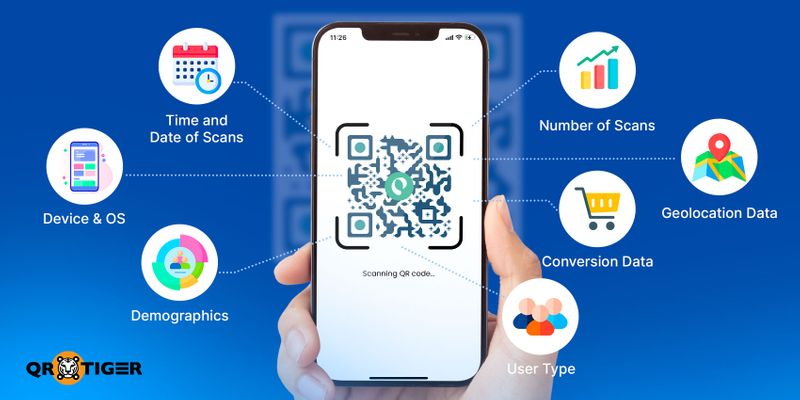
Here are the key QR code engagement metrics to remember:
- Number of scans – Overall engagement level with your QR code campaign.
- Time and date of scans – When customers are most likely to interact.
- Geolocation data – Where scans are happening, helping refine targeting and regional strategies.
- Device type and operating system – Shows whether users prefer iOS, Android, or desktop.
- Unique vs. repeat scans – Distinguishes between new and returning engagements.
- User demographics (where available) – Age, gender, or other attributes, depending on campaign setup.
- Conversion data – Tracks whether a scan led to specific actions like purchases, sign-ups, or app downloads.
This data turns QR codes into performance-driven tools, giving brands the proof they need to optimize campaigns and maximize ROI.
The ROI potential of QR code campaigns
The QR code market is projected to grow 16.9% annually and reach $33.13 billion by 2030, a trajectory that reflects rising demand and shows how QR codes are shaping the future of marketing as a cost-efficient, long-term investment.
With frequent scans, strong conversions, and actionable analytics, QR codes provide marketers with clear, measurable ROI.
1. Optimizing campaign performance through QR scan metrics
QR codes have become powerful drivers of marketing ROI. By tracking and analyzing scan behavior, marketers can optimize campaigns, personalize experiences, and make informed decisions that directly impact the bottom line.
- Scan Volume and Timing: Identifies peak engagement periods. QR code scans continue to grow rapidly year over year, reflecting steadily increasing user engagement and improved QR code campaign performance.
- Geographical Insights: Shows where scans originate for targeted campaigns. 54.33% of QR codes created are URL-based, facilitating location-based targeting and personalized content delivery
- Device and Browser Information: Ensures content is optimized for common platforms. Businesses using dynamic QR codes see significantly higher engagement than with standard QR codes.
- Post-Scan Behavior: Tracks actions like sign-ups or purchases to measure effectiveness. Many marketers struggle to track the customer journey after a QR scan, highlighting the value of QR code scan analytics in understanding user behavior.
Marketers see meaningful campaign lift from better tracking: QR campaigns produce up to 26% higher engagement compared to campaigns without tracking.
Additionally, 75% reported improved first-party data collection through QR code strategies, enhancing personalization and targeting efforts.
By monitoring key metrics companies can optimize their marketing strategies, improve user engagement, and achieve better financial outcomes.
2. Flexible marketing with dynamic QR code technology
The adoption of dynamic QR codes has significantly enhanced marketing campaign performance, transforming marketing by offering unparalleled flexibility and real-time adaptability.
Unlike static QR codes, dynamic QR codes let marketers update destinations and track user behavior in real time, enabling campaigns to adapt quickly and maximize ROI.
- Real-Time Updates. Frequently update dynamic QR codes for promotions, product changes, or seasonal campaigns, keeping content relevant. A significant portion of marketers update QR code destinations monthly, highlighting the growing demand for solutions that can pivot on the fly.
- Analytics. QR code tracking and reporting can boost engagement by up to 26%. Over 60% of marketers report that dynamic QR codes improve campaign insights, helping them tailor content and offers more effectively.
- A/B Testing Capabilities. Marketers can test different content or offers using the same QR code. Data shows that campaigns leveraging A/B testing see an average 18% increase in conversions.
- Cost Efficiency. Reduce marketing costs by eliminating the need for reprints, as one code can support multiple campaigns over time. Over half of companies are expanding their use of QR codes, drawn by their flexibility and cost-efficient impact on marketing campaigns.
Analytics show that over 70% of dynamic QR code campaigns are updated monthly for personalized, context-driven marketing, optimizing engagement and conversions.
Dynamic QR code tracking provides marketers the flexibility, data, and insights to drive measurable marketing results.
3. Cost-effective marketing that outperforms print and digital
When stacked against traditional media, QR campaigns deliver high conversions and computable ROI, compounding value with both efficiency and performance.
Studies show QR campaigns deliver 18% average conversion rates, far above print or broadcast benchmarks. ClearLine adds that 57% of scans are for coupons or discounts, and QR-engaged customers spend an average of $16.74 more per visit.
75% of restaurants globally use QR codes for digital menus, delivering 40% customer engagement with minimal setup and no printing costs, demonstrating high ROI.
Brands using QR codes to create interactive, seamless experiences boost customer engagement three to four times more than traditional digital ads.
Traditional direct mail typically sees just a 4.4% response rate, while QR campaigns fall between 4.5% and 6.4%, outperforming it by a wide margin.
In short, QR strategies increase conversions, spending per user, reduce media costs, and demonstrate strong QR code cost-effectiveness.
4. Improving customer engagement
In 2025, G2 revealed key QR code engagement statistics: 59% of smartphone users scan QR codes daily, while 9 in 10 engage at least once a week, 28% scan weekly, and only 4% rarely or never scan, clear proof that QR codes have gone fully mainstream.
Beyond frequency, the depth of engagement is noteworthy. 61% of consumers have scanned a QR code on a product after purchasing it, accessing additional content such as recipes, user manuals, or exclusive offers.
Demographically, QR adoption is strongest among younger adults, with 18–34-year-olds accounting for nearly 70% of frequent scanners.
Usage among older groups is steadily rising. QR code analytics show that 45% of users aged 35–54 scan at least monthly, and 68% of all users fall between 24 and 54, including Millennials and Gen X engaging with QR codes for shopping, payments, and digital content.
What was once dismissed as a passing fad is now a daily habit, with every scan showing intent to connect.
5. Delivering measurable marketing results
High engagement alone wouldn’t matter if it didn’t translate into results. Luckily, QR codes deliver on both fronts, delivering outcomes that surpass traditional channels.
The high ROI of QR code in marketing campaigns is not a make-believe.
In 2025, 95% of businesses use them to capture first-party data, a crucial asset as third-party cookies fade.
Even more compelling, QR-initiated journeys generate an average click-through rate (CTR) of 37%, far outperforming email campaigns, display ads, and other digital touchpoints.
Retailers and restaurants report scan-to-purchase rates above 30%, especially for promotional or personalized campaigns, outperforming traditional digital channels.
QR codes play a significant role in enhancing customer retention. A 5% increase in customer retention can lead to a profit increase of up to 95% over time.
From data capture to conversion rates, QR codes deliver measurable ROI that traditional channels struggle to match.
Best practices for growing ROI of QR code campaigns
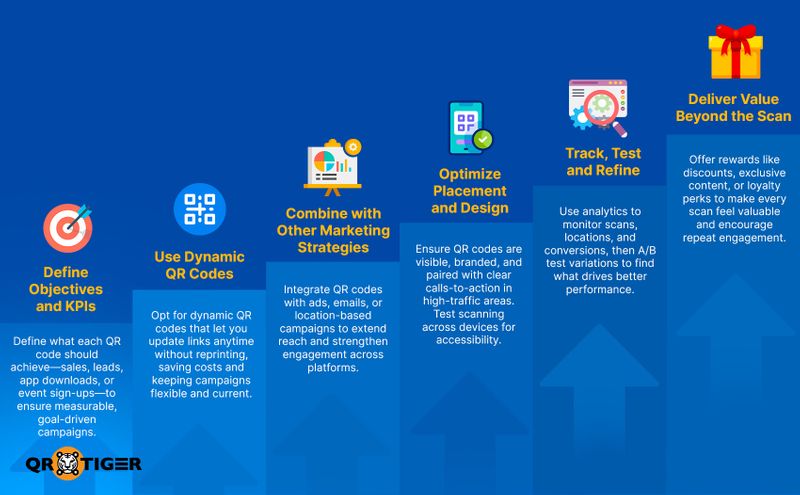
Getting strong ROI from QR codes isn’t just about placing them on marketing materials—it’s about using them strategically. Here are proven ways to maximize their effectiveness:
Set clear goals for every QR code
Before launching a QR code, decide what you want it to achieve: driving sales, capturing leads, increasing app downloads, or boosting event attendance.
Clear goals make it easier to track success and align campaigns with broader business objectives.
Use dynamic QR codes for flexibility
Unlike static codes, dynamic QR codes allow you to update the destination anytime without reprinting. This flexibility lowers costs and ensures campaigns stay relevant, even if messaging or offers change.
Combine QR codes with other marketing strategies
QR codes deliver the best results when integrated into a larger marketing mix. Pair them with retargeting ads, email campaigns, or geofencing strategies to extend engagement.
For example, scanning a code could trigger personalized follow-up ads across social media.
Optimize placement and design
Make QR codes highly visible and easy to scan. Use branded QR codes that match your brand identity, add a call-to-action (“Scan to get 20% off”), and place them in high-traffic locations where customers naturally engage.
Accessibility is key, test them across devices to avoid friction.
Track, test, and refine campaigns
Use analytics from dynamic QR codes to monitor performance in real time. Look at metrics like scan rate, location, and conversions.
Run A/B tests, such as comparing two different landing pages or CTAs, and refine based on which version drives higher ROI.
Deliver value beyond the scan
Make sure scanning the QR code feels rewarding. Offer exclusive discounts, VIP access, how-to content, or loyalty points. The more value customers get, the more likely they are to engage again and share the experience with others.
ROI calculation framework for QR code campaigns
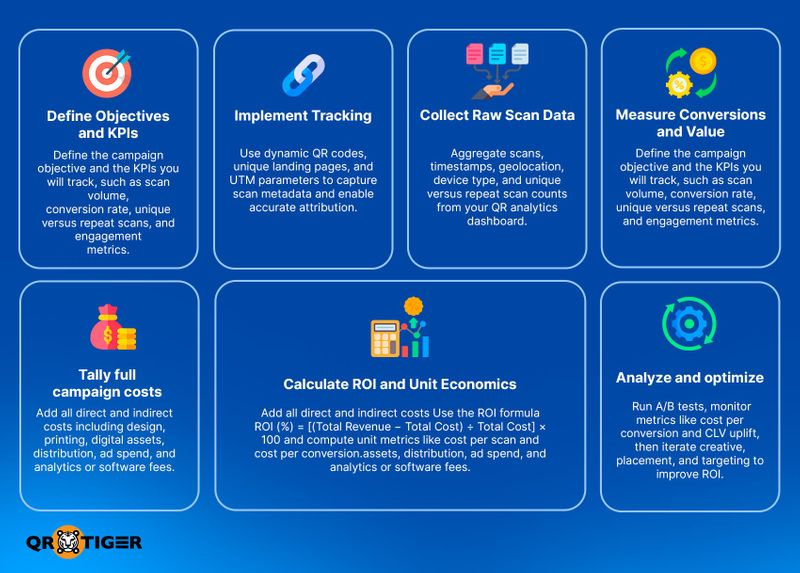
Before investing in QR codes long-term, it’s essential to understand how to measure the ROI of your existing campaigns.
At its core, ROI comes from comparing the measurable benefits of QR-driven interactions against the costs of creating, deploying, and managing the campaign.
To calculate the ROI of QR code powered campaigns effectively, you should first establish clear KPIs that connect scans to measurable business outcomes.
- Scan volume – how many people interact with the QR code.
- Unique vs. repeat scans – shows if users are returning.
- Conversion rate – percentage of scans that result in a desired action (purchase, signup, download).
- Cost per scan (CPS) – total campaign spend divided by total scans.
- Customer engagement metrics – dwell time, clicks, or subsequent actions.
Tracking these KPIs ensures QR code campaigns are evaluated not just by activity, but by the tangible value they create.
Understanding your QR campaign investment
Accurately measuring ROI requires accounting for every expense tied to the dynamic QR code campaign, such as:
- Design & production of QR codes (printing, packaging integration)
- Digital assets (landing pages, videos, app integration)
- Marketing & distribution (ads, emails, in-store displays)
- Analytics & software costs (QR code tracking platforms)
By capturing all direct and indirect costs involved, you ensure ROI calculations reflect the true investment behind your campaigns.
Quantifying QR code success
Once benefits and costs are defined, use the ROI calculation framework for QR code campaigns to measure performance.
ROI (%) = [(Total Campaign Revenue – Total Campaign Cost) ÷ Total Campaign Cost]
× 100
With QR codes, revenue attribution depends on the actions taken after the scan, making accurate tracking essential.
Streamlining ROI calculations with a template
This template helps brands plug in campaign data to quickly calculate ROI and assess performance.
| Campaign Element | Example Input | Notes and Formula |
| Total Campaign Cost | $1,000 | Includes printing, design, and QR code generator subscription |
| Total Scans | 5,000 | Trackable via dynamic QR code dashboard |
| Conversion Rate | 10% | Percentage of scans that lead to action |
| Conversions | 500 | Total actions (e.g., purchases, sign-ups) |
| Average Order Value (AOV | $20 | Or revenue per conversion |
| Total Revenue | $10,000 | Conversions × AOV |
| ROI (%) | 900% | [(Revenue – Cost) ÷ Cost] × 100 |
By customizing these inputs, you will be able to evaluate real-world returns and compare performance across multiple QR code campaigns.
Maximizing QR code returns
To see how the ROI framework works in practice, consider a restaurant that launches a QR code campaign on printed flyers offering a 10% discount.
- Objective: Drive in-store sales (sales growth).
- Costs: $500 for flyer printing and distribution.
- Returns: 1,000 scans lead to 200 coupon redemptions, generating $5,000 in sales.
- ROI: ($5,000 – $500) ÷ $500 × 100 = 900% ROI.
This example illustrates how even a modest QR code investment can yield substantial returns, proving that clear objectives, KPI tracking, and monitoring cost per conversion turn QR campaigns into powerful revenue drivers.
To calculate the QR code cost per conversion, use this formula:
Cost per conversion = monthly QR code generator subscription cost ÷ number of conversions
Going beyond basic ROI
Beyond basic ROI, advanced metrics provide deeper insight into the efficiency and long-term impact of QR code campaigns.
- Cost per scan: Total Costs / Number of scans
- Cost per conversion: Total Costs / Number of conversions
- Conversion rate: (Conversions / Scans) x 100
- Customer lifetime value (CLV) uplift: Track how QR engagement impacts repeat purchases.
These advanced metrics help you refine campaign strategies, optimize spending, and measure value beyond one-time interactions.
QR code campaign benchmarks: Sector-wise analysis
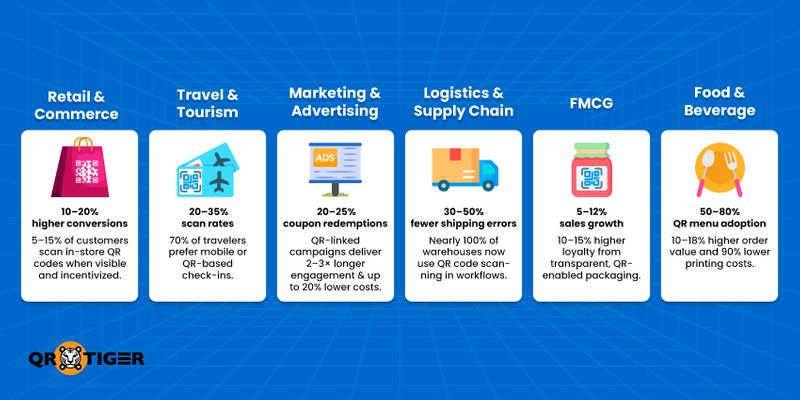
Recent studies show that companies integrating QR codes into marketing and operational workflows see notable improvements in campaign performance, data capture, and customer interactions.
Below, industry-specific benchmarks based on global industry studies highlight QR code campaign effectiveness and their measurable ROI in real-world applications.
Retail and commerce
From checkout to marketing, QR codes have become a cornerstone of modern retail strategies, enhancing both customer experiences and business operations.
- Scan Rates: 5–15% of customers scan in-store QR codes when visible and incentivized. This is significantly higher than the average digital ad click-through rate of under 1%.
- Sales Lift: Retailers report 10–20% higher conversion rates when QR codes are tied to discounts, tutorials, or reviews.
- Loyalty Impact: Brands like Starbucks and Nike attribute 30–40% of sales to QR-enabled loyalty apps and mobile payment systems.
- Cost Savings: By shifting to QR-based self-service menus, guides, and help centers, businesses reduce customer service queries by 20–25%, lowering labor costs.
Use of QR codes in retail has surged, with an 88% year-over-year increase in generation and 64% of shoppers scanning codes in-store for product information and reviews, unlocking the ROI potential of QR codes in retail.
Travel and tourism
In travel and tourism, QR codes streamline access to tickets, guides, and bookings, offering visitors convenience while delivering measurable ROI for operators.
- Scan Rates: Tourism-related QR codes see 20–35% scan rates, highlighting strong tourism QR code engagement in airports and cultural attractions.
- Sales Lift: Attractions and tour operators using QR-linked upsells, such as merchandise, premium tours, or food vouchers, report 10–15% higher revenue per visitor.
- Loyalty Impact: QR-enabled boarding passes and digital transit tickets encourage repeat use, with airlines and metro systems reporting 5–8% higher repeat bookings and card reloads.
- Cost Savings: Digital ticketing and e-boarding passes via QR reduce printing and distribution costs by 25–40%, while also cutting wait times and streamlining operations
QR adoption in tourism surged after the pandemic, with 70% of travelers now preferring mobile or QR-based check-ins over paper tickets. This shift highlights how QR codes have become a cornerstone of digital-first travel.
Marketing and advertising
QR codes have become a powerful bridge between offline campaigns and digital engagement, unlocking the ROI potential of QR code campaigns by giving brands a low-cost way to boost reach and trackable results.
- Scan Rates: Campaigns see 4–10% scan rates, especially when tied to gamification or rewards.
- Sales Lift: QR-linked coupons achieve redemption rates of 20–25%, compared to under 2% for print
- Engagement: Interactive QR campaigns deliver 2–3x longer engagement through video, AR, or microsites.
- Cost Savings: Extending static ads with QR reduces reliance on extra print materials, saving 15–20% in campaign costs.
QR codes turn one-way ads into two-way experiences, giving marketers both richer data and higher conversion.
Logistics and supply chain
In logistics, the operational ROI of QR code tracking is less about marketing and more about precision. It ensures accuracy, visibility, and efficiency across the supply chain.
- Scan Rates: Adoption is near 100% in warehouses, delivery hubs, and returns, since scanning is built into workflows.
- Efficiency Gains: QR-enabled tracking cuts picking and shipping errors by 30–50%, streamlining operations.
- Cost Savings: Fewer mis-shipments save companies millions annually in refunds, rework, and lost sales.
- Customer Impact: Real-time visibility via QR boosts satisfaction scores by 15–20%
For supply chains, ROI comes from fewer errors and faster fulfillment, turning QR codes into a backbone of logistics tech.
Fast-moving consumer goods (FMCG)
For consumer brands, QR codes turn packaging into a digital touchpoint, driving engagement, transparency, and sales.
- Scan Rates: 10–20% of shoppers scan QR codes on packaging when tied to recipes, AR, or promotions.
- Sales Lift: Brands like Coca-Cola, Heinz, and PepsiCo have seen 5–12% sales growth during QR-driven campaigns.
- Loyalty Impact: QR-enabled product transparency (origin info, certifications) boosts brand trust and loyalty by 10–15%.
- Cost Savings: Digitalizing manuals and nutrition info via QR trims packaging costs by 5–10%.
For these companies, the ROI of interactive packaging in FMCG is twofold: higher sales and loyalty on the revenue side, paired with cost savings and efficiency on the operational side.
Food and beverage
QR codes have become standard in dining, from digital menus to loyalty programs, reshaping how customers order, pay, and engage.
- Scan Rates: QR menus see 50–80% adoption, especially after the pandemic.
- Sales Lift: Upsell prompts on QR menus boost average ticket size by 10–18%.
- Loyalty Impact: Starbucks reports 40–50% of transactions through QR-enabled loyalty; McDonald’s notes 10% higher satisfaction from QR table ordering.
- Cost Savings: Digital menus cut 90% of printing costs and speed up ordering, improving table turnover by 15–20%.
For restaurants, QR codes deliver ROI both in higher sales and leaner operations, making them a long-term fixture beyond the pandemic.
Case studies: QR code marketing success across industries
From boosting sales to building loyalty ecosystems, successful QR code campaigns show that brands can achieve tangible ROI, not just convenience.
Global brands are proving that QR codes aren’t just convenient—they drive measurable returns across sales, loyalty, and efficiency, offering clear QR code campaign benchmarks for businesses to follow.
Starbucks
Starbucks has placed QR codes at the core of its customer experience, weaving them into its mobile ordering and loyalty ecosystem.
Customers scan to pay, collect rewards, and access personalized offers. Today, 40–50% of Starbucks transactions run through QR-enabled systems, fueling repeat purchases and higher customer lifetime value.
Nestlé
Nestlé has turned its product packaging into an interactive channel by adding QR codes that connect shoppers to recipes, sourcing details, promotions, and nutrition guides.
The strategy has paid off. Nestlé reports 5–10% sales growth during promotional periods driven by QR-linked campaigns.
As part of its QR code campaign optimization, the company also reduces packaging costs while building stronger engagement and brand trust.
McDonald’s
McDonald’s has integrated QR codes into its dining experience by enabling table ordering, app-linked promotions, and seamless service flows.
This digital shift highlights the ROI of QR codes in restaurant operations: locations using QR-based ordering report 10% higher customer satisfaction and stronger repeat visits.
It has become a tool for boosting loyalty and driving sales through convenience and promotions.
Coca-Cola
Coca-Cola uses QR codes on bottles and cans to connect customers with interactive campaigns, rewards, and personalized digital content.
By scanning, consumers can instantly access promotions or engage with branded experiences, making the product more than just a drink.
This strategy has delivered measurable results, with engagement rates climbing by up to 12% and noticeable sales lifts during seasonal promotions.
Heinz
Heinz printed QR codes on ketchup bottles that linked customers to recipes, promotions, and sustainability initiatives.
This simple move turned an everyday product into an interactive packaging with QR codes, creating a direct bridge between customers and the brand.
The campaign was a success, driving over 1 million scans in just a few months. This surge in engagement translated into stronger customer connection and a clear sales boost.
Preparing for the next phase of QR adoption
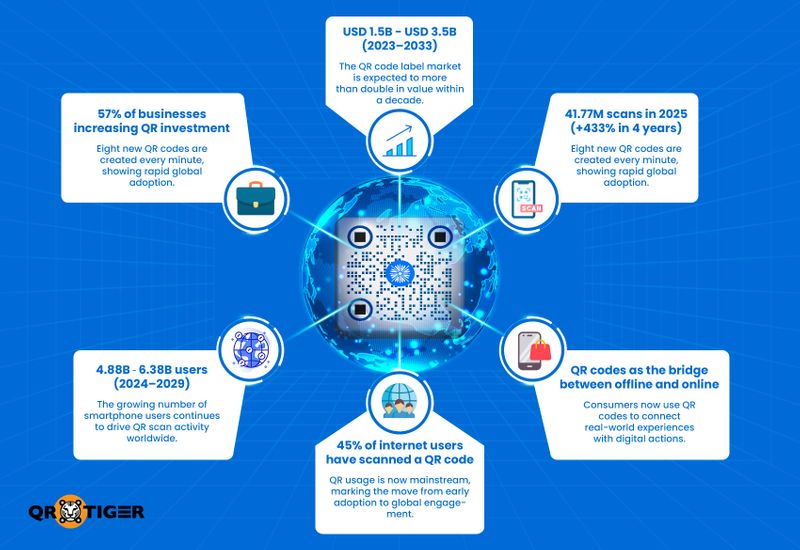
Future Market Insights reports that the QR code labels market is growing from USD 1.5 billion in 2023 to USD 3.5 billion by 2033.
Adoption mirrors this growth. Recent QR code statistics show a global surge with scans expected to reach 41.77 million in 2025, a 433% increase in just four years. Every minute, eight new QR codes are created, reflecting a 47% year-on-year growth rate.
This surge aligns with shifting consumer behavior, where QR codes are now seen as the preferred bridge between offline and online channels.
Nearly 45% of internet users worldwide have scanned a QR code at least once, underscoring its shift from early adoption to global mainstream and highlighting the growing ROI of QR code campaigns.
Smartphone proliferation fuels this momentum: with 4.88 billion global users in 2024 projected to grow to 6.38 billion by 2029, scan volumes will only accelerate.
The convergence of adoption, effectiveness, and scalability solidifies QR codes as foundational tools in digital marketing.
With these numbers, it’s evident that QR code adoption will accelerate even further. 57% of businesses are already increasing their investment in QR codes, giving way to strategic integration across payments, logistics, and marketing.
This shift signals more than efficiency gains. It highlights how brands will increasingly measure, maximize, and scale their ROI with QR code adoption in the years ahead.
Increase your ROI with QR codes
The takeaway is clear: QR codes are no longer just a convenience, they’re a proven ROI driver.
From boosting sales to reducing costs and unlocking real-time insights, they deliver measurable results that traditional channels can’t match.
For brands, the opportunity to maximize QR code ROI is now. By defining clear goals, tracking performance, and aligning QR codes with customer needs, any brand can turn scans into measurable ROI.
Ready to get started? Launching a QR code campaign is simple, scalable, and cost-effective with the right dynamic QR code generator that enhances customer engagement and results.
The future of engagement is already here. Don’t wait to make QR codes part of your growth strategy. 


